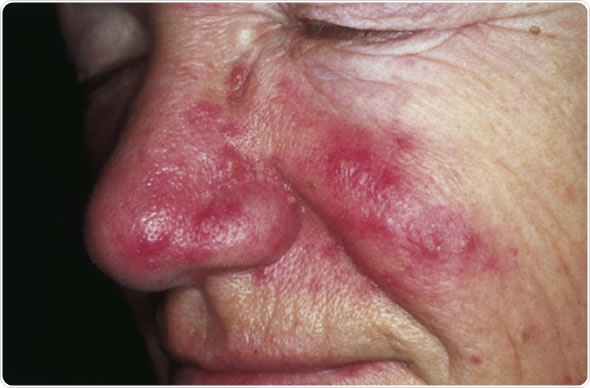Rosacea Causes

Rosacea is typically characterized by a redness and discoloration across the face, accompanied by persistent red spots and the appearance of prominent blood vessels. Over time, the skin may thicken and enlarge and eventually cause facial deformity.

Causes
The cause of rosacea is not yet clear but there are several hypotheses regarding the mechanisms of pathology which include:
Some research suggests that this bacteria produces a protein called bradykinin that can cause blood vessels to dilate, giving rise to rosacea symptoms.
- Abnormal vasculature
Rosacea is typically characterized by flushing, redness and prominent blood vessels across the face. Sun exposure can lead to dilation of blood vessels and the release of inflammatory mediators that cause this redness. Sun can also damage the elasticity of the skin by degrading collagen.
- Genetics
Although no particular gene that causes rosacea has yet been identified, the condition has been known to run in families, suggesting it may be an inherited condition.
- Parasites
Demodex folliculorum is a type of tiny mite found on human skin that has been implicated as a cause of rosacea. They have been observed in higher numbers on the affected skin of rosacea patients than on healthy people's skin
- Helicobacter pylori bacteria
- Environmental toxins
Caffeine-containing drinks, alcohol, spicy food, steroid creams and vitamin B supplements have been implicated in the causation of rosacea.
Triggers of rosacea
There are several triggers that may worsen rosacea symptoms and these include:
- Exposure to sunlight
- Stress
- Exposure to wind or cold weather
- Exposure to heat, humidity or hot baths
- Vigorous exercise
- Alcohol
- Caffeine
- Dairy products
- Spicy food
- Flu, fever or cold
Sources
- http://www.nhs.uk/Conditions/Rosacea/Pages/Introduction.aspx
- http://www.cumc.columbia.edu/student/health/pdf/R-S/Rosacea.pdf
- http://www.nejm.org/doi/pdf/10.1056/NEJMcp042829
- http://www.isclinical.com/whitepapers/rosacea.pdf
- www.oxforddaysurgery.com.au/…/2009-03-23_17-44-06_Rosacea.pdf
Further Reading
- All Rosacea Content
- Rosacea – Facial Redness
- Rosacea Symptoms
- Rosacea Epidemiology
- Rosacea Subtypes
Last Updated: Feb 27, 2019

Written by
Dr. Ananya Mandal
Dr. Ananya Mandal is a doctor by profession, lecturer by vocation and a medical writer by passion. She specialized in Clinical Pharmacology after her bachelor's (MBBS). For her, health communication is not just writing complicated reviews for professionals but making medical knowledge understandable and available to the general public as well.
Source: Read Full Article